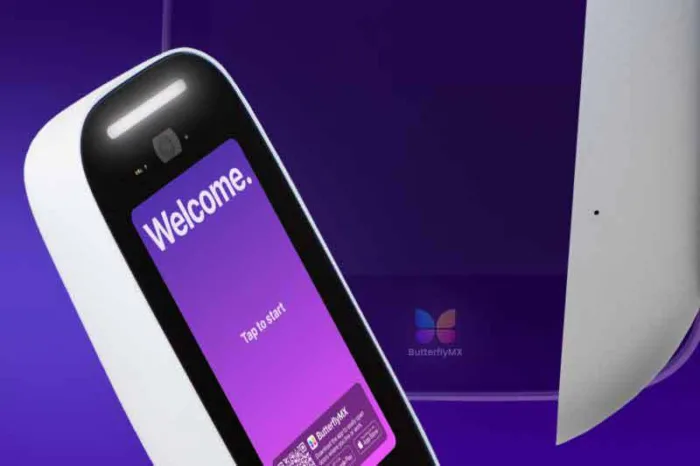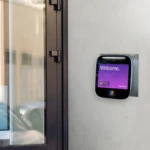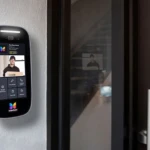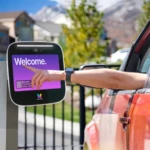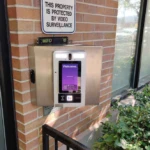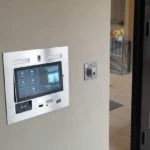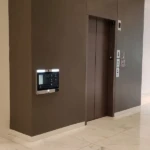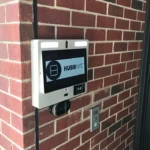Key takeaways:
- An apartment intercom system with door release is a building intercom that sends audio (and sometimes video) footage from an intercom to a tenant.
- Apartment building intercom systems offer benefits, including improved visitor access, package deliveries, and security.
- Today’s apartment intercom systems require a base station installed at the property’s entryway, and a tenant’s smartphone is used as the substation, empowering tenants to manage access from anywhere.

Whether replacing an existing apartment intercom system or choosing one for a new building, you’ve come to the right place. We’re here to help you find the best video intercom system that fits your budget, makes residents’ lives easier, and improves building operations for property managers and owners.
So, we’ve created this ultimate guide to help you find the right intercom for your multi-tenant apartment building. Read on to learn everything you need to know about intercom systems for apartment buildings.
Watch how ButterflyMX works:
This guide will cover:
- 19 best apartment intercom systems
- Types of apartment intercom systems
- How does an apartment intercom system with door release work?
- How much does an intercom system for apartment buildings cost?
- Benefits of an apartment video intercom system
- How to choose an apartment intercom system for your apartment
- Questions to ask before choosing a video intercom system for apartment buildings
19 best apartment intercom systems
- ButterflyMX
- Doorking
- Aiphone
- Akuvox
- DoorBird
- 2N
- Comelit
- Mircom
- Latch
- Linear
- Siedle
- LiftMaster
- Enterphone
- Whoo
- MVI Systems
- 1Valet
- Avigilon
- Paxton
- Invictus
1. ButterflyMX
ButterflyMX introduced the apartment Video Intercom system as a property technology innovator in 2014. Although our flagship product has been enhanced over the years, our mission remains to empower people to open doors and manage access from a smartphone.
Since launching, ButterflyMX has been installed in over 15,000 buildings and garnered over 40,000 five-star reviews.
In addition to opening doors with your phone, the ButterflyMX apartment intercom system lets you remotely grant access to guests, integrate with your property management system, eliminate building wiring and in-unit hardware, and more. The modern intercom features a sleek touchscreen interface and a top-rated mobile app for an improved resident experience.
Uses
- Multifamily/apartments
- Commercial
- Mixed-use buildings
- Gated communities
- Student housing
- Senior housing
- HOAs and condominiums
- Self-storage facilities
- Industrial properties
Features
- Two-way video calling
- Smartphone-based access and management through a top-rated mobile app
- No building wiring
- No in-unit hardware
- 5GHz WiFi
- Sleek and durable touchscreen interface with an 8” or 12” screen
- Multiple access options, including Visitor Passes, door PINs, RFID, and delivery PINs
- Cloud-based property admin dashboard with resident management tools
- Audit trail with time- and date-stamped photos of every door entry
- 156º wide-angle camera that captures a majority of the intercom surroundings for peak security
- Elevator Controls
- Vandal-resistant and weatherproof
- Contactless entry
- Integrations with property management systems, Access Control Systems, keyless locks, and more
- Can be surface- or recess-mounted
- Stylish design is aesthetically pleasing and improves your curb appeal
Here’s a quote from one of our many satisfied customers:
I’ve been using the ButterflyMX intercom system for our main and service building door intercom, and I couldn’t be happier with it. This system has truly made access management a breeze. The user-friendly interface and remote access features have simplified our daily routines. It’s not just convenient; it’s also incredibly secure, giving us peace of mind. The ButterflyMX team has been responsive and supportive throughout our experience. I highly recommend this system for anyone looking to upgrade their building’s security and access control!
Pros and cons
Pros:
- No wiring and no in-unit hardware make for a simple and affordable installation.
- Smartphone-based access is convenient, intuitive, and more affordable than installing devices in every unit.
- The cloud-based dashboard makes it easy to manage the tenant directory and integrate it with property management software.
- The time- and date-stamped audit trail provides an extra layer of security.
- Elevator Control integrations make for easy property access while only allowing guests to visit the floor of the unit they are visiting.
Cons:
- No solution for single-family homes
- Features and functionality may be too much for apartment intercom systems with fewer than 10 units.
Watch what property brother Jonathan Scott has to say about ButterflyMX video:
2. Doorking Intercom
Doorking — also known as DKS — offers a wide range of traditional telephone entry systems.
Features:
- Traditional telephone entry systems
- Some models are PC-programmable
- Some models feature built-in directories
Pros:
- Durable
- Weather- and tamper-resistant
- Traditional design
Cons:
- May not have built-in camera/video intercom options
- May not offer cloud-based access management
- The cellular connection could require the purchase of a separate DKS Cellular Connection Box
- Not all models are PC-programmable
- May not have a mobile app
- No touchscreen interface
3. Aiphone Intercom
A self-proclaimed security communication systems brand, Aiphone offers a variety of intercom systems for apartment buildings for several industries with a focus on security.
Features:
- Several product series with many models tailored to both large and small buildings
- Video intercom options
- Touchscreen, handset, and keypad interfaces are available
Pros:
- Supports building complex/multi-building connections
- Modern video and touchscreen options are available
Cons:
- Not all systems are cloud-based
- Most models require in-unit hardware
- Not all systems offer remote management
4. Akuvox Intercom
Akuvox is a well-known player in the access control industry. Offering a variety of apartment intercom systems, Akuvox provides technological solutions for buildings across multiple industries.
Features:
- Options range from simple video intercom doorbells and multi-button doorphones to smart video intercoms
- Touchscreen and keypad interfaces, depending on the model
- Weather- and tamper-resistant
Pros:
- Enables touchless entry
- SmartPlus and Vfone mobile apps work with smart intercoms
- Options available for both small and large buildings
Cons:
- Most systems require indoor/in-unit hardware
- Indoor monitors use Android or Linux operating systems
- SmartPlus and Vfone mobile apps have few ratings in the app store
- Company based in China and may not have support in the United States
5. DoorBird Intercom
Based in Germany, DoorBird is a company in the IP Intercom communication field.
Features:
- Keypad and call button interfaces
- Wide-angle cameras on all models
- Simple, straightforward design
Pros:
- Easy to install
- Open API for integrations with third-party home automation and access control systems
- Mobile app to answer calls and grant remote access from a smartphone
Cons:
- Limited touchscreen models
- May only be suitable for multi-tenant buildings with up to 100 units
- Could lack cloud-based remote management for multifamily buildings
- May be unreliable
6. 2N Intercom
2N is a European access control company operating internationally since 1991.
Features:
- Touchscreen or keypad interface, depending on the model
- Built-in Ethernet port
- Entry options include Bluetooth, touchpad, RFID card reader, and fingerprint reader entry options
Pros:
- Mobile app available to answer telephone and video calls and to open doors from a smartphone
- Remote management and administration capabilities
- Modular intercoms allow you to add specific features and customize your intercom
Cons:
- The 2N mobile app has limited user ratings for both the Android and iOS versions
- May have a low video resolution
7. Comelit Intercom
Founded in 1956 in Val Seriana, Italy, Comelit (officially Comelit Group SpA) designs and manufactures various products, from video entry and surveillance systems to home automation and access control systems.
Features:
- Two-way video calling when you install indoor video panels in each unit
- Mobile app for remote property access
- Weather-resistant, though IP ratings vary between models
Pros:
- Integrations with access control systems such as Prodatakey, Salto, etc.
- Mobile app allows for remote door management from a smartphone
Cons:
- All models may not be IP65-rated
- Certain features may only be available on some models
- It may be difficult to know which models include specific features
- Comelit mobile app has fewer ratings in both the Apple App Store and Google Play Store when compared to ButterflyMX
- It’s unclear how to learn more about products, get a quote, or purchase a system from a sales representative
8. Mircom Intercom
Founded in 1991, Mircom designs, manufactures, and distributes various products, from fire detection and alarm systems, access control systems, and voice entry systems to mass notification systems and emergency lighting.
Features:
- Various interfaces, including touchscreen, keypad, and direct-dial buttons
- Most systems require in-unit hardware, though some are compatible with smartphones and tablets using Mircom’s mobile app, MiEntry
Pros:
- Mircom offers an extensive catalog of products applicable across many industries
- Various mounting options, including flush mount, surface mount, and pedestal mount
Cons:
- Not all units are weather-resistant
- MiEntry app has limited ratings in both the Google Play Store and Apple App Store
- There are few company reviews available online, which could raise questions about product durability and reliability
- Intercom design may not be visually appealing, and touchscreen interfaces appear cluttered
- Could require purchase through a distributor
9. Latch Intercom
Founded in 2014, Latch originally focused its product lineup on smart locks. However, Latch has started exploring new territories, introducing its multi-unit building intercom in December 2019.
Features:
- Residents can choose how to display their name on the intercom
- Power over Ethernet
- Three connectivity options: Ethernet, WiFi, and cellular
Pros:
- Remote door unlock capabilities
- Multiple connectivity options
Cons:
- No built-in camera — video capabilities require purchasing and installing a separate camera
- A small screen may make it difficult to read or find a tenant
- The Latch mobile app has limited customer reviews, averaging less than five stars in both the Apple App Store and Google Play Store
- May not have a touchscreen
10. Linear Intercom
Nortek Security & Control owns Linear, an access control brand based in Carlsbad, California.
Features:
- Offers the Entry Pro line with three models and the more basic AE-100 Telephone Entry System
- All Entry Pro models offer audio-only calling with backlit keypads, two I/O ports, and compatibility with most third-party VoIP adapters and long-range readers
- EP-736 model includes a touchscreen display
Pros:
- Durable intercoms
- Clear audio
Cons:
- May not include built-in cameras
- Appears to only offer audio-only calling
- Only one model has a touchscreen display
- May not have a mobile app for smartphone-based access
- Cluttered and dated design
- May lack features such as Visitor Passes for guest access and door release audit trail
11. Siedle Intercom
Siedle is a German company offering a variety of telecommunications systems, from intercoms to security devices.
Features:
- Siedle offers both audio-only and video intercom options
- Dome camera on video intercoms
- Day/night switchover
Pros:
- Intercoms are modular and customizable
- Straightforward design
- Modular intercoms offer useful add-ons like a card, key, and fingerprint readers
Cons:
- No touchscreen options
- Not cloud-based
- Mobile app could be difficult to set up
- Video intercoms may only allow for one-way video calling
- May not accommodate very large buildings
12. LiftMaster Intercom
LiftMaster develops and sells access control systems for homes, apartments, businesses, and other properties.
Features:
- LiftMaster offers both audio-only and video intercoms
- LiftMaster does not offer in-unit hardware; intercoms must be connected to existing phone numbers or operated with a smartphone through LiftMaster’s mobile app
- Touchscreen and keypad interface options
Pros:
- Functional for various types of properties
- Straightforward design
Cons:
- May lack integrations with property management software
- Could require local dealer or installer for purchase
- Limited reviews from users and buyers
13. Enterphone Intercom
Enterphone is a line of telephone entry systems sold by Hirsh Secure.
Features:
- The Enterphone iQ has a 10-inch HD screen with a keypad. Enterphone 19 and 21 have a touchscreen interface
- All three systems offer residential or business listing formats with drop-down menus
- Enterphone telephone entry systems can be surface-mounted or flush-mounted
Pros:
- Enterphone’s telephone entry systems automatically redial a secondary number if the first number doesn’t answer
- Unlimited administrators
Cons:
- The smallest intercom size is 10”, which may be too large for smaller buildings or secondary entrances
- No built-in cameras, so tenants can’t see who’s at the door
- No mobile app; therefore, residents can’t open the door or gate with their smartphones
- Enterphone’s telephone entry systems don’t integrate with third-party proptech providers or products
14. Whoo Intercom
Whoo is an intercom provider founded in 2015 by Arturo Falck. Falck originally intended to develop products with facial recognition technology, but he focused on developing access control products for apartment buildings.
Features:
- 7-inch LCD touchscreen display
- Built-in camera
- Mobile app for remote access
Pros:
- Smartphone enabled, so residents can video chat with visitors before letting them in
- IP65 rated
Cons:
- Third-party hardware, which isn’t designed or manufactured by Whoo
- May not integrate with property management software or other smart access control products
- Does not appear to have an option for recurring smart keys
15. MVI Systems Intercom
Founded in 2016, MVI Systems is a software development company whose primary product is its KeyCom® video intercom. Based in Brooklyn, the company focuses mostly on the multifamily market, although it also sells to commercial properties.
Features:
- 12” and 15” intercom options
- Built-in camera
- MVI myKey™ mobile app
Pros:
- Multiple entry methods, including fobs, PIN codes, and smartphone-based access
- Remote access through the mobile app
- Video call and voicemail
Cons:
- If the MVI intercom experiences any issues, you may have to pay an installer to come on-site because MVI Systems may not have a robust customer support team
- Users report that MVI intercoms may be prone to system crashes
- User interface may be overly complicated for many users
16. 1Valet Intercom
Founded in 2017, Canada-based company 1Valet offers a video intercom system designed specifically for multifamily properties.
Features:
- Built-in camera
- Resident mobile app and a separate app for property managers
- Property management portal
Pros:
- Remote access through the mobile app
- Video calling
- Delivery management system
- Guest parking management system
Cons:
- Facial recognition technology may introduce privacy concerns
- Since 1Valet is a fairly new company and may not be as established as other providers
- 1Valet may only be designed for multifamily buildings, not commercial or industrial properties
- The intercom has a large footprint and takes up a lot of space — the smallest intercom model is 22″
- 1Valet doesn’t appear to offer any additional access control products, such as keypads or key lockers, for access beyond the front door
17. Avigilon Video Intercom Reader Pro (formerly Openpath)
Founded in 2016, Openpath is an access control company focused primarily on access solutions for offices and other commercial real estate. After being acquired by Avigilon in 2023, Openpath’s products became part of Avigilon’s security and access control offerings.
Features:
- Tenants can use Openpath on their smartphones, watches, or tablets to open the door
- Openpath can be configured to work with key cards or fobs that use RFID technology
- When a visitor calls a tenant, the tenant can see their guest, but visitors can’t see tenants
Pros:
- Mobile app for smartphone based access
- Multiple entry methods
Cons:
- Some users report a poor mobile app design
- Wave-to-Unlock battery draining for smartphones
- No tenant directory
18. Paxton Intercom
Paxton is a UK-based access control company founded in 1985. Early on, Paxton started selling keypad access devices. However, the company eventually started branching out into other access and security solutions, like security cameras and intercom systems. Paxton has expanded into international markets and has a U.S. headquarters in South Carolina.
Features:
- Paxton intercom panels have a built-in RFID fob and key card reader.
- Paxton sells in-unit devices that must be installed in each unit. In-unit hardware options include touchscreen monitors and handsets.
- Paxton offers two intercom models: a touch screen panel and a keypad. The keypad model has a single-line digital display, which could make it difficult to skim the tenant directory.
Pros:
- Built-in RFID reader
- Video calling
Cons:
- No delivery carrier access solutions
- Small display on keypad model
- In-unit hardware
19. Invictus Intercom
Invictus is a software development company specializing in property management products.
Features:
- End-to-end integrations with several property management systems.
- Digital key push notifications
- Time-stamped photos and videos
Pros:
- Intercom has a 3D, 1080p HD industrial-grade touchscreen
- Camera takes time-stamped photos, which are stored in an activity log
- Can integrate with multiple property management systems to increase visitor monitoring and tenant communications
Cons:
- The Invictus mobile app doesn’t have great reviews on the Google Play Store
- Lack of diverse entry options, like card readers and keypads.
Images of video intercom systems for apartments
Types of apartment intercom systems
The system you choose will impact the access experience for residents, staff, and visitors alike, so take the time to consider various types of intercoms before you purchase one.
The main types of apartment intercom systems are:
- Wireless intercoms
- Cloud-based intercoms
- Video intercoms
- IoT intercoms
- Front desk vs. multi-tenant intercom
Wireless apartment intercom systems
Intercoms can be wired or wireless — and we can’t stress the importance of this choice enough. When selecting an apartment intercom system, you need it wired when it’s important and wireless when it’s not.
When apartment intercom wiring is important
We generally recommend against intercoms that operate over a cellular connection or WiFi. Systems with a wired internet connection are far more reliable, and cellular or WiFi issues outweigh the benefits of a wireless connection.
Buildings are made of concrete, steel, and lots of copper wiring, which causes issues for most wireless devices. Imagine your visitor being stuck outside in a rainstorm while you’re unable to open your door for them because of your intercom’s internet connection.
We suggest you pick an intercom wired directly to the internet and the door it controls. This way, no one will ever be stuck outside in the rain.
When apartment intercom wiring is not important
Wiring and installation costs will quickly increase if your apartment intercom system requires wiring throughout the building to each apartment unit. What should be a quick and easy addition to your property becomes a costly and time-consuming project. On top of that, future upgrades will require you to rewire the building all over again.
So, to save time and money, select an apartment intercom system with door release that doesn’t require building wiring to each apartment or in-unit hardware to receive calls.
A good intercom system for apartment buildings will send those calls to residents’ cell phones so they can speak with visitors and open the door. A better intercom system will let you send video calls to a mobile app so residents can see visitors. The best apartment intercom system with door release will let you do both.
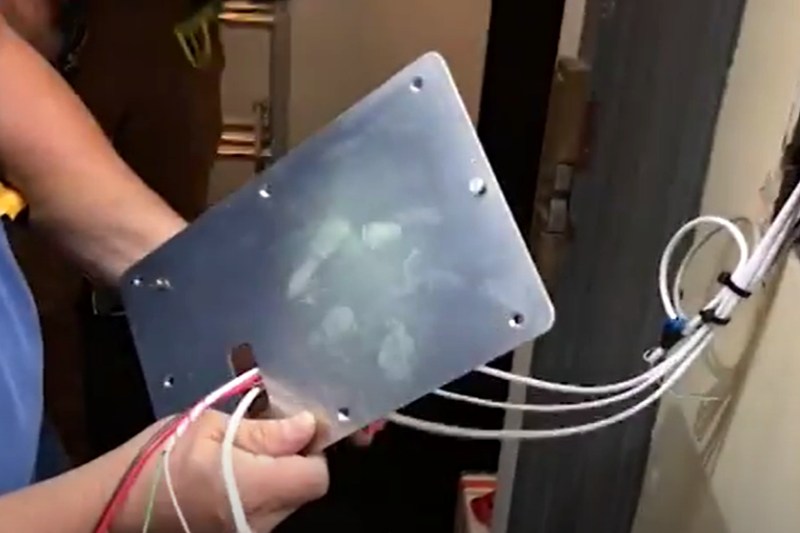
Cloud-based intercoms
Property staff members aren’t always on site. But now that many of today’s intercoms are powered by the internet and store data in the cloud, a staff member doesn’t have to be on a property to manage it.
Just like tenants want to open the door for their guests remotely, property staff will appreciate a system that lets them remotely manage the apartment intercom system with door release. So, choose a cloud-based video intercom with online management capabilities so building staff can remotely manage who enters the building.
Cloud-based intercoms also allow property managers and owners to remotely:
- Update the resident directory
- Add & revoke tenant permissions
- Offer self-guided tours, reducing the need for an on-site leasing agent
- View audit trails of door releases to keep track of who has entered the building
Video intercom systems
Today’s apartment residents need a reliable visitor management system for their friends, family, and delivery people. While you may remember when you could trust anyone you let into your building, those days are gone. Thanks to social media, the rise of e-commerce, and the gig economy, renters expect to be able to see who they’re letting into the building.
An intercom system for apartment buildings with a built-in video camera is a security must-have because:
- Residents and building staff can see who’s at the door before letting them in. This lets you confirm that your visitors are who they say they are.
- It can reduce the risk of vandalism. When visitors approach your property and see themselves displayed on the intercom screen, they’ll believe they’re being recorded. A reminder that a camera is watching is all they need to avoid vandalizing or breaking in.
IoT intercoms
In contrast to a traditional analog intercom, an IoT intercom uses the internet to enhance its functions. Through an IoT intercom, visitors and residents can communicate wirelessly. The intercom’s internet connection supports superb audio communication and may even support video calling.
Front desk vs. multi-tenant intercom
Apartment intercom systems can be sorted into two categories: front desk and multi-tenant intercoms. A front desk intercom only places calls to the front desk or leasing office. In contrast, a multi-tenant intercom lets visitors call a specific tenant within the building. In nearly every situation, multi-tenant intercoms are better.
Multi-tenant intercom systems are more convenient for residents, who can speak directly with their visitors. They’re also more convenient for building staff, who won’t have to operate the intercom system at the front desk 24 hours a day. Property managers are always on the go — showing apartments, fixing issues, and interacting with tenants. They don’t have time to receive calls from an intercom and grant property access.
How does an apartment intercom system with door release work?
An apartment intercom system with door release enables visitors to call and request access from a tenant or building staff member upon arrival.
Here’s how an apartment intercom system with door release works:
- To enter the building, visitors must use the intercom directory to look up the person they want to request property access. Typically, visitors call a resident or staff member.
- When visitors find the right person in the intercom directory, they push a ‘call’ button to notify them.
- The tenant or staff member receives this notification on either a buzzer installed in their apartment unit or another device, such as a smartphone. From there, the resident or staff member can either dismiss the call, talk to the visitor, or open the door.
- If the tenant or staff member decides to open the door for the visitor, an electronic relay is triggered inside the intercom installed at the building’s entrance. Triggering this relay sends a signal to a door-releasing mechanism (an electronic or magnetic lock), unlocking the entryway and letting the visitor enter the property.
How much does an intercom system for apartment buildings cost?
Today’s apartment intercom systems cost between $1,000 and $7,000, not including installation or maintenance fees.
Apartment intercom system installation and maintenance costs are more difficult to calculate. Each installation company estimates its fee based on the materials needed and the difficulty of the installation. Ongoing maintenance costs will vary depending on the number of hardware devices purchased and the wiring used to install that hardware.
Since every building has different hardware and wiring needs, you must contact a certified installer and compare your options.
Factors that affect intercom hardware & installation costs
- The number of intercom systems needed. If your building has one entryway, you may only need one intercom. However, if your building has multiple entries — such as side doors, garage entrances, etc. — you may need to purchase multiple intercoms for each door.
- Location of installation. Intercoms installed on a wall near the door they control are typically cheaper than intercoms mounted on a pedestal 20 feet away because of the additional wiring and labor needed.
- The intercom’s wiring requirements. Wiring costs include purchasing cables, opening up walls to run those cables, and hiring people to do all the work. So, if the apartment intercom system you select requires wiring throughout your building, the price will be higher.
- Installing hardware in every apartment unit. If you choose an apartment intercom system with door release that requires in-unit hardware, you’ll have a higher upfront bill. Not only do you need to purchase the additional in-unit hardware, but you’ll also have to pay the labor and material costs to install it. Your future maintenance and upgrade costs will increase since all the in-unit hardware must be maintained or replaced.
Benefits of apartment intercom systems
- Improve security. Apartment building intercom systems keep tenants safe. They’re a vital layer of security that lets staff and tenants control who enters the building. They also give renters peace of mind because anyone who visits the property has been vetted and authorized.
- Enable package deliveries. Package management is a huge pain point for property staff. With an intercom in your apartment building, staff and tenants can grant couriers seamless property access.
- Increase visitor management capabilities. Multi-tenant properties need a way to communicate with visitors and grant them property access — and an intercom is the best solution.
- Add convenience. Modern tenants want convenience. Please don’t make them go downstairs to open the front door for guests. Instead, let them grant remote property access with an intercom.
- Improve the resident experience to retain residents. The security and convenience an intercom brings to apartment buildings helps shape a positive experience and gives residents a reason to renew their leases year after year.
- Managed visitor access. Every apartment building needs an intercom system to manage visitor access. Intercom systems for apartment buildings include tenant directories that allow visitors to call specific residents, making it easier to grant access.
How to choose an apartment intercom system for your apartment
You now know why your building needs an apartment intercom system and the different types of intercom systems for apartment buildings. But how do you choose one?
When purchasing a building intercom, look for reliable, secure, and convenient systems.
Features to look for when choosing an apartment building intercom:
- Mobile app
- Integrations with other systems
- Delivery management solution
- Supports multiple property access methods
- Supports multiple entrances
- Contactless and touchless entry options
- Reliable provider with a good track record
Mobile app
Intercom systems for apartment buildings paired with a mobile app allow you to open the door from anywhere in the world. This lets renters grant entry to delivery people and service providers—such as house cleaners or dog walkers—even when they aren’t home. It also lets building staff remotely grant property access to maintenance people and prospective renters.
The best intercoms with a mobile app let you see everyone who has called or messaged from the intercom. You’ll also get a history of door releases to review anytime.
Before choosing a system with a mobile app, check the app’s ratings. If users report that the app is buggy, unreliable, or has no reviews, it might not be the right fit. The last thing you need is for your residents, staff, or visitors to be locked outside because the app doesn’t work.

Integrations with other systems
Apartment residents seek convenience — but so do property managers. So, choose an apartment intercom system that can integrate with your other systems, whether your property management software or access control system.
If your apartment intercom system connects to your property management system, you won’t waste time updating multiple databases. So, when you add or remove tenants from your property management system, they’re automatically added or removed from your intercom.
Connecting to other proptech amenities, such as smart locks, provides a seamless living experience for residents. Tenants can open the building and apartment doors using the same mobile app.
Delivery management solution
With the growth in e-commerce, managing package deliveries has become a big project for apartment residents and owners. Now that we order everything from a bar of soap to a king-sized bed online, property managers must accept and store all those packages.
Choose an apartment intercom system for apartment buildings that allows you to assign delivery PIN codes to each carrier. This way, couriers can access the building and complete deliveries without involving tenants or building staff. The intercom should also take a photo of anyone who uses a delivery PIN for added security.
Once the delivery person is inside your building, they can leave the package in the lobby or store it in a room or locker. Package rooms provide a secure and convenient way to receive and store packages at your apartment building. You can even control access to your package room with an apartment intercom system with door release.
Supports multiple property access methods
Aside from enabling communication between residents and visitors, intercom systems for apartment buildings provide property access. Traditional intercom systems usually only offer a door-open button on in-unit hardware — think of the old-school buzzer system where a resident pushes a button in their apartment to open the door for their guest.
Over the years, however, apartment intercom systems with door release have been designed to offer multiple property access methods.
Property access methods include:
- Door PINs
- Mobile app
- Visitor Passes
- Facial recognition
- Voice controls
- Bluetooth
Supports multiple entrances
The best apartment intercom systems can control multiple building entrances. For example, perhaps you have a vestibule with two doors in a row. If this is the case, sometimes you may want both doors to open (like when a tenant grants property access to a guest), and sometimes you want the first door to open (like when a delivery person drops off a package).
The best intercom systems will also allow you to manage multiple entrances from an online portal. This way, you can control each door and update your system remotely without being on-site.
Contactless and touchless entry options
Contactless entry for apartment buildings is the ability to provide a visitor with remote property access. This means you can grant property access to guests, delivery people, and maintenance professionals remotely — without physically being at the building or coming in close contact with that individual. Apartment intercom systems that offer contactless entry options are a must-have for tenants who are always on the move. They’re also crucial for building staff who work remotely or manage multiple properties.
Touchless entry, on the other hand, allows residents, visitors, and building staff to open doors without touching them. Touchless entry for apartment buildings adds convenience and safety. It’s convenient to avoid manually opening building doors while your hands are full of groceries. It’s also safer because it reduces the risk of spreading germs through contact. To offer touchless entry at your building, be sure the apartment intercom system you pick can connect to an automatic door opener.
Watch how touchless entry works with ButterflyMX:
Reliable provider with a good track record
If you’ve narrowed your options to just a few intercom systems for apartment buildings but still can’t choose, look at each company’s reviews. See what others are saying about their products. The apartment intercom system with door release you install should be a worthwhile investment lasting years. So, buy from a company with a positive reputation and a strong track record of reliability and service.
Before purchasing, search for company reviews online. You can also ask fellow real estate professionals for their advice and opinions.
Questions to ask before choosing a video intercom system for apartment buildings
- Do you want one- or two-way video?
- Do you want to install in-unit hardware?
- Do you need a multi-apartment intercom system to support the number of tenants?
- Do you want to manage the system remotely?
- Is granting remote property access a priority?
Do you want one- or two-way video?
Some video intercoms offer one-way video calling, where the tenant can see a visitor, but the visitor can’t see the tenant. Others offer two-way video calling, which lets the tenant and the visitor see each other. Two-way video requires a secondary device for the tenant, such as an in-unit device or the tenant’s smartphone.
Do you want to install in-unit hardware?
Intercom systems for apartment buildings require two components: a base station at the entrance for visitors and substations inside for tenants. Advancements in technology have made it possible to replace in-unit hardware with a device that most residents already have in their pockets: a smartphone.
Smart video intercom systems for apartment buildings eliminate the need for in-unit hardware by empowering tenants to use the intercom with their smartphones. Instead of relying on devices installed in each building unit, tenants can open and manage doors with their smartphones, creating a more seamless and convenient experience.
Two benefits of a smartphone-based video intercom system for apartment buildings are:
- Cost savings: With a smartphone-based apartment entry system, there’s no need to run wiring and install hardware in each renter’s apartment unit. The cost of purchasing and installing the necessary wiring and hardware adds up quickly, so for most properties, a smart video intercom is more cost-effective.
- Convenience: With a smartphone-based video intercom, residents can unlock the door for visitors, delivery carriers, and service providers no matter where they may be — in their unit, at the gym, or out walking the dog. Residents also don’t have to worry about carrying keys or fobs everywhere because they can unlock the door with their smartphone.
Do you need a multi-apartment intercom system to support the number of tenants?
Consider how many tenants will use your video intercom daily and what they need. Some camera intercom systems limit the number of apartments they can support, and others limit the number of tenants per apartment.
So, make sure whatever multi-apartment intercom system you choose is reliable and can handle the traffic at your property. The last thing any renter wants is to get locked out because the entry system gets overwhelmed.
Do you want to manage the system remotely?
With many older building entry systems, you must go on-site to update the directory or manage permissions. Not only is this an inefficient use of time, but these on-site servers cost a lot of money and take up a lot of space.
If you want to control access and manage the system from anywhere, choose a smartphone-based video intercom with cloud-based software.
Is granting remote property access a priority?
Some video intercoms allow tenants and staff to open the door or gate even when they are not at the property. Consider whether this is an important feature for your building.
Keep in mind the many benefits of granting remote access. Even small HOAs receive a lot of package deliveries and visitors who need temporary access to the building. With remote access features, your video intercom system for apartment buildings empowers staff and residents to let people in from anywhere. Not only is this more convenient, but it also prevents package theft and ensures you see footage of exactly who is coming through the door.
Disclaimer: ButterflyMX provides these blog posts to help our customers and potential customers make the right business decisions. Our blog posts are based on the information available to us at the time of writing.

Learn more about ButterflyMX
Fill in the form below, and we'll email you right back.
Have questions?
Fill in the form below, and we'll email you right back.
